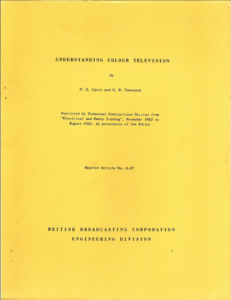On 1 July 1967, the British Broadcasting Corporation launched Europe’s first colour service with the Wimbledon tennis championships shown on BBC 2. This was after several years of experimention and training. The first official colour programme on BBC 1 was a concert by Petula Clark from the Royal Albert Hall, London, broadcast at midnight on 14/15 November 1969. The reason for the strange time? It was because the Postmaster General’s colour broadcasting licence began at exactly this time!
This set of reprints describe the both development of compatible colour televiosn – that is, colour television signals that could also produce acceptable, good quality signals on monochrome (black and white) television sets, and provide full information for the engienners who had t maintain the sets,
Walk into Studio H Lime Grove in the mid 1960s. The display monitors had some thirty-odd controls for the colour, the cameras were three-tube Image Orthicon cameras (unimaginatively called “coffins” – they were HUGE! – and brightly lit sets. Oh, and by the way, the camera viewfinders were black and white, so there was no use in the director saying “Pan left on to the blue cushion…”
 |
The Development of Compatible Colour Television |
| The stages in the development of colour television may be characterised by the different ways of assigning signals to the colour parameters.
It was only by adopting the principle of separate signals for the luminance and the chrominance that the psycho-physical features of the sense of colour (imperfection in the recognition of detail in colour) could be utilised for reducing the frequency bandwidth. This led to the “compatible” transmission process which was first put into practice with the development of the American NTSC system. The special problem lies in the type of transmission and the accommodation of the two colour signals in the upper frequency region of the luminance signal. The article describes the variants of colour-signal modulation proposed by several laboratories in Europe and compares them by means of schematic diagrams. This systematic survey explains the differences and also the common principles distinguishing the various colour systems. At the same time, it looks at other proposals which have brought about important contributions to colour television development.
|
 |
Understanding Colour Television |
Colour Television started tests on 625 lines in late 1962 – Studio H, Lime Grove, was converted for colur experimenation and training. Technical magazines, such as Electrical and Radio Trading began around this time to present a series of articles explaining both the NTSC and SECAM systems which were to be used in the tests. There was a hope that colour would become a regular thing when the BBC 2 625 service started in 1964, and because of this, far-seeing dealers and their engineers were already preparing for C-Day. In the event, BBC 2 broadcast its first colour pictures from Wimbledon in 1967. By mid 1968, nearly every BBC2 programme was in colour. Six months later, colour came to BBC1.
|
Back to top
Back to reprint index



